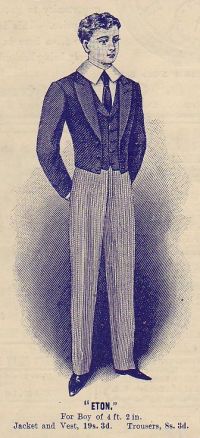Eton College
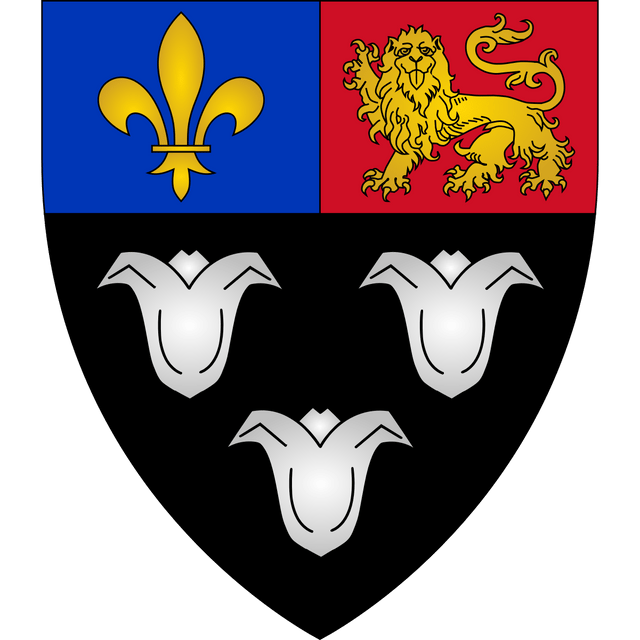
Eton College

| Eton College | |
|---|---|
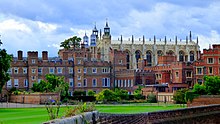 Eton College | |
| Location | |
Eton ,,SL4 6DW England | |
| Coordinates | 51°29′31″N 0°36′29″W [142] |
| Information | |
| Type | Public, independent, boarding school |
| Motto | Latin: Floreat Etona (May Eton Flourish) |
| Religious affiliation(s) | Church of England |
| Established | 1440 (1440) |
| Founder | Henry VI |
| Local authority | Windsor and Maidenhead |
| Department for Education URN | 110158 [143] Tables [144] |
| Provost | The Lord Waldegrave of North Hill |
| Head Master | Simon Henderson |
| Gender | Boys |
| Age range | 13–18 |
| Enrolment | 1,313 (2019)[1] |
| Capacity | 1,325[1] |
| Student to teacher ratio | 8:1 |
| Houses | 25 |
| Colour(s) | Eton blue |
| Song | Carmen Etonense |
| Publication |
|
| School fees | £42,501 per year[2] |
| Affiliations |
|
| Alumni | Old Etonians |
| Website | www.etoncollege.com [145] |
| Charity Commission. Eton College, registered charity no. 1139086 [146] . | |
 | |
Eton College (/ˈiːtən/)[3] is a 13–18 independent boarding school and sixth form for boys in the parish of Eton, near Windsor in Berkshire, England. It was founded in 1440 by King Henry VI as Kynge's College of Our Ladye of Eton besyde Windesore (The King's College of Our Lady of Eton beside Windsor),[4] as a sister institution to King's College, Cambridge, making it the 18th-oldest Headmasters' and Headmistresses' Conference school. Eton's history and influence have made Eton one of the most prestigious schools in the world.[5]
Following the public school tradition, Eton is a full boarding school, which means pupils live at the school seven days a week,[6] and it is one of only four such remaining single-sex boys', boarding-only independent senior schools in the United Kingdom (the others being Harrow, Radley, and Winchester).[7] The remainder have since become co-educational: Rugby (1976), Charterhouse (1971), Westminster (1973),[8] and Shrewsbury (2014) and Merchant Taylors' which is now a day school. Eton has educated prime ministers, world leaders, Nobel laureates and generations of the aristocracy and has been referred to as "the chief nurse of England's statesmen".[9]
Eton charges up to £42,501 per year[10] (£14,167 per term, with three terms per academic year, in 2019).[11] Eton was noted as being the sixth most expensive HMC boarding school in the UK in 2013/14,[12] however the school admits some boys with modest parental income:[13] in 2011 it was reported that around 250 boys received "significant" financial help from the school,[14] with the figure rising to 263 pupils in 2014, receiving the equivalent of around 60% of school fee assistance, whilst a further 63 received their education free of charge. Eton has also announced plans to increase the figure to around 320 pupils, with 70 educated free of charge, with the intention that the number of pupils receiving financial assistance from the school continues to increase.[13]
| Eton College | |
|---|---|
 Eton College | |
| Location | |
Eton ,,SL4 6DW England | |
| Coordinates | 51°29′31″N 0°36′29″W [142] |
| Information | |
| Type | Public, independent, boarding school |
| Motto | Latin: Floreat Etona (May Eton Flourish) |
| Religious affiliation(s) | Church of England |
| Established | 1440 (1440) |
| Founder | Henry VI |
| Local authority | Windsor and Maidenhead |
| Department for Education URN | 110158 [143] Tables [144] |
| Provost | The Lord Waldegrave of North Hill |
| Head Master | Simon Henderson |
| Gender | Boys |
| Age range | 13–18 |
| Enrolment | 1,313 (2019)[1] |
| Capacity | 1,325[1] |
| Student to teacher ratio | 8:1 |
| Houses | 25 |
| Colour(s) | Eton blue |
| Song | Carmen Etonense |
| Publication |
|
| School fees | £42,501 per year[2] |
| Affiliations |
|
| Alumni | Old Etonians |
| Website | www.etoncollege.com [145] |
| Charity Commission. Eton College, registered charity no. 1139086 [146] . | |
 | |
History
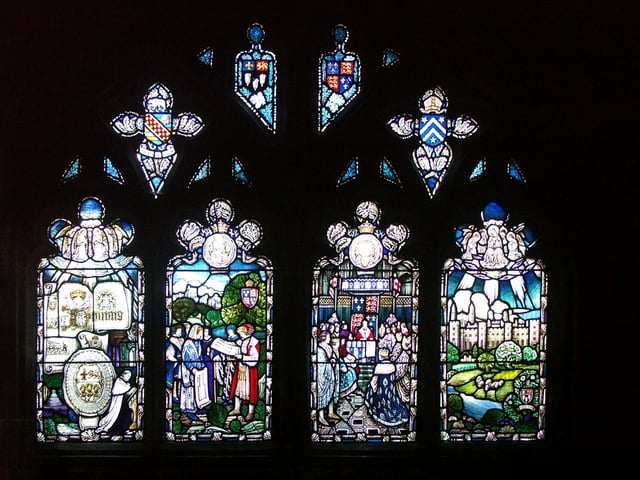
Stanberry Window (1923) in Hereford Cathedral, showing Bishop John Stanberry advising King Henry VI on the founding of Eton College
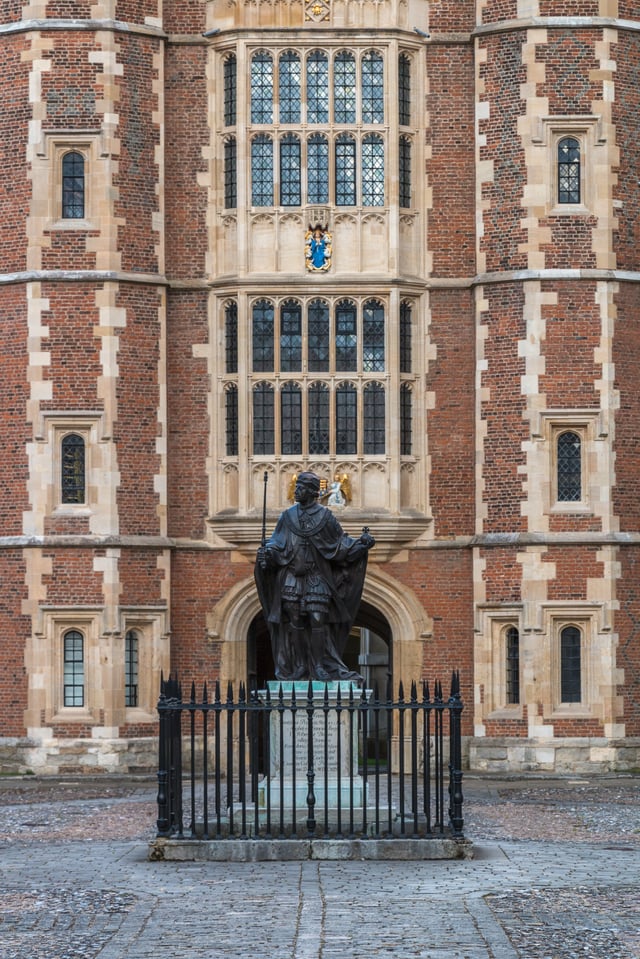
Statue of the founder, Henry VI, in School Yard
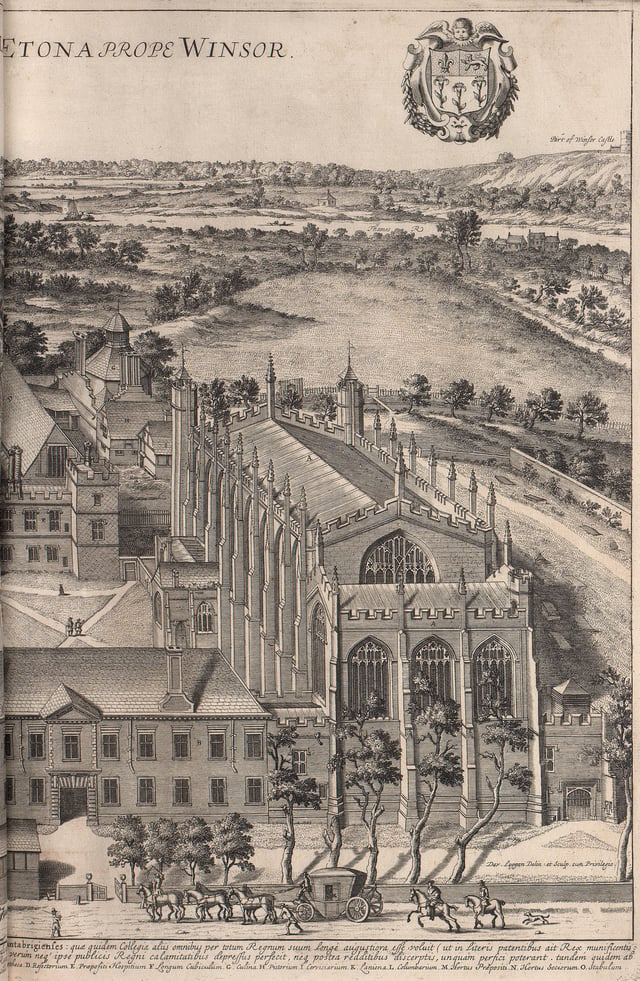
Eton College in 1690, in an engraving by David Loggan
Eton College was founded by King Henry VI as a charity school to provide free education to 70 poor boys who would then go on to King's College, Cambridge, founded by the same King in 1441. Henry took Winchester College as his model, visiting on many occasions, borrowing its statutes and removing its headmaster and some of the scholars to start his new school.
When Henry VI founded the school, he granted it a large number of endowments, including much valuable land. The group of feoffees appointed by the king to receive forfeited lands of the Alien Priories for the endowment of Eton were as follows:[15]
Archbishop Chichele
Bishop Stafford
Bishop Lowe
Bishop Ayscough
William de la Pole, 1st Marquess of Suffolk (1396–1450) (later Duke of Suffolk)
John Somerset (d. 1454), Chancellor of the Exchequer and the king's doctor
Thomas Beckington (c. 1390–1465), Archdeacon of Buckingham, the king's secretary and later Keeper of the Privy Seal
Richard Andrew (d. 1477), first Warden of All Souls College, Oxford, later the king's secretary
Adam Moleyns (d. 1450), Clerk of the Council
John Hampton (d. 1472) of Kniver, Staffordshire, an Esquire of the Body[16]
James Fiennes, another member of the Royal Household
William Tresham, another member of the Royal Household
It was intended to have formidable buildings (Henry intended the nave of the College Chapel to be the longest in Europe) and several religious relics, supposedly including a part of the True Cross and the Crown of Thorns.[17] He persuaded the then Pope, Eugene IV, to grant him a privilege unparalleled anywhere in England: the right to grant indulgences to penitents on the Feast of the Assumption. The college also came into possession of one of England's Apocalypse manuscripts.
However, when Henry was deposed by King Edward IV in 1461, the new King annulled all grants to the school and removed most of its assets and treasures to St George's Chapel, Windsor, on the other side of the River Thames. Legend has it that Edward's mistress, Jane Shore, intervened on the school's behalf. She was able to save a good part of the school,[18] although the royal bequest and the number of staff were much reduced.
Construction of the chapel, originally intended to be slightly over twice as long,[19] with 18, or possibly 17, bays (there are eight today) was stopped when Henry VI was deposed. Only the Quire of the intended building was completed. Eton's first Headmaster, William Waynflete, founder of Magdalen College, Oxford and previously Head Master of Winchester College,[20] built the ante-chapel that completed the chapel. The important wall paintings in the chapel and the brick north range of the present School Yard also date from the 1480s; the lower storeys of the cloister, including College Hall, were built between 1441 and 1460.[21]
As the school suffered reduced income while still under construction, the completion and further development of the school has since depended to some extent on wealthy benefactors. Building resumed when Roger Lupton was Provost, around 1517. His name is borne by the big gatehouse in the west range of the cloisters, fronting School Yard, perhaps the most famous image of the school. This range includes the important interiors of the Parlour, Election Hall, and Election Chamber, where most of the 18th century "leaving portraits" are kept.
"After Lupton's time, nothing important was built until about 1670, when Provost Allestree gave a range to close the west side of School Yard between Lower School and Chapel".[22] This was remodelled later and completed in 1694 by Matthew Bankes, Master Carpenter of the Royal Works. The last important addition to the central college buildings was the College Library, in the south range of the cloister, 1725–29, by Thomas Rowland. It has a very important collection of books and manuscripts.
19th century onwards

An Eton College classroom in the 19th century

Pupils at Eton College dressed as members of various rowing crews taking part in the "Procession of Boats" on the River Thames during the "Fourth of June" celebrations 1932
In the 19th century, the architect John Shaw Jr (1803–1870) became surveyor to Eton. He designed New Buildings (1844–46),[23] Provost Francis Hodgson's addition to providing better accommodation for collegers, who until then had mostly lived in Long Chamber, a long first-floor room where conditions were inhumane.[24]
Following complaints about the finances, buildings and management of Eton, the Clarendon Commission was set up in 1861 as a royal commission to investigate the state of nine schools in England, including Eton.[25] Questioned by the Commission in 1862, headmaster Edward Balston came under attack for his view that in the classroom little time could be spared for subjects other than classical studies.[26]
The Duke of Wellington is often incorrectly quoted as saying that "The Battle of Waterloo was won on the playing-fields of Eton".[27] Wellington was at Eton from 1781 to 1784 and was to send his sons there. According to Nevill (citing the historian Sir Edward Creasy), what Wellington said, while passing an Eton cricket match many decades later, was, "There grows the stuff that won Waterloo",[28] a remark Nevill construes as a reference to "the manly character induced by games and sport" among English youth generally, not a comment about Eton specifically. In 1889, Sir William Fraser conflated this uncorroborated remark with the one attributed to him by Count Charles de Montalembert's C'est ici qu'a été gagné la bataille de Waterloo ("It is here that the Battle of Waterloo was won").
As with other public schools,[29] a scheme was devised towards the end of the 19th century to familiarise privileged schoolboys with social conditions in deprived areas.[30] The project of establishing an "Eton Mission" in the crowded district of Hackney Wick in east London was started at the beginning of 1880, and it lasted until 1971 when it was decided that a more local project (at Dorney) would be more realistic. However over the years much money was raised for the Eton Mission, a fine church by G. F. Bodley was erected; many Etonians visited and stimulated among other things the Eton Manor Boys' Club, a notable rowing club which has survived the Mission itself, and the 59 Club for motorcyclists.
The very large and ornate School Hall and School Library (by L. K. Hall) were erected in 1906–08 across the road from Upper School as the school's memorial to the Etonians who had died in the Boer War. Many tablets in the cloisters and chapel commemorate the large number of dead Etonians of the Great War. A bomb destroyed part of Upper School in World War II and blew out many windows in the Chapel. The college commissioned replacements by Evie Hone (1949–52) and by John Piper and Patrick Reyntiens (1959 onward).
Among headmasters of the 20th century were Cyril Alington, Robert Birley and Anthony Chenevix-Trench. M. R. James was a provost.
In 1959, the college constructed a nuclear bunker to house the college's provost and fellows. The facility is now used for storage.[31]
In 2005, the school was one of fifty of the country's leading independent schools found to have breached the Competition Act 1998 (see below under "Controversy").
Coat of arms
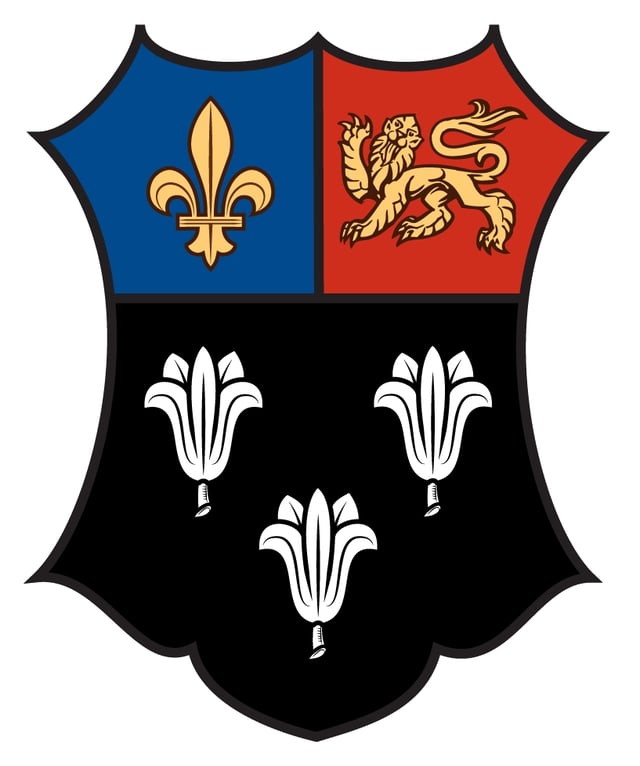
Arms of Eton College: Sable, three lily-flowers argent on a chief per pale azure and gules in the dexter a fleur-de-lys in the sinister a lion passant guardant or
The coat of arms of Eton College was granted in 1449 by the founder King Henry VI, as recorded as follows on the original charter, attested by the Great Seal of England and preserved in the College archives:[33]
- *On a field sable three lily-flowers argent, intending that Our newly-founded College, lasting for ages to come, whose perpetuity We wish to be signified by the stability of the sable colour, shall bring forth the brightest flowers redolent of every kind of knowledge; to which also, that We may impart something of royal nobility which may declare the work truly royal and illustrious, We have resolved that that portion of thearms which by royal right belong to Usin the Kingdoms of France and England be placed on the chief of the shield, per pale azure with aflower of the French, and gules with aleopard passant or*.
Thus the blazon is: Sable, three lily-flowers argent on a chief per pale azure and gules in the dexter a fleur-de-lys in the sinister a lion passant guardant or. Although the charter specifies that the lily-flowers relate to the founder's hope for a flourishing of knowledge, that flower is also a symbol for the Virgin Mary, in whose honour the College was founded, with the number of three having significance to the Blessed Trinity. The motto of the College is Floreat Etona ("may Eton flourish"). The grant of arms to King's College, Cambridge, is worded identically, but with roses instead of lily-flowers.[33]
Overview

Eton College
The school is headed by a provost and fellows (board of governors) who appoint the head master. It contains 25 boys' houses, each headed by a housemaster, selected from the more senior members of the teaching staff, which numbers some 155.[34] Almost all of the school's pupils go on to universities, about a third of them to Oxford or Cambridge.[35]
The headmaster is a member of the Headmasters' and Headmistresses' Conference and the school is a member of the Eton Group of independent schools in the United Kingdom.
Eton has a long list of distinguished former pupils. In 2019, Boris Johnson became the 20th British prime minister to have attended the school,[36] and the fifth since the end of the Second World War[37] David Cameron was the 19th British prime minister to have attended the school,[38][39] and recommended that Eton set up a school in the state sector to help drive up standards.[40]
Fame

Eton College, Provost's Garden
Eton has educated generations of British and foreign aristocracy, and for the first time, members of the British royal family in direct line of succession: Prince William and his brother Prince Harry, in contrast to the royal tradition of male education at either naval college or Gordonstoun, or by tutors.
The Good Schools Guide called the school "the number one boys' public school", adding that "The teaching and facilities are second to none."[43] The school is a member of the G20 Schools Group.
Financial support
About 20% of pupils at Eton receive financial support, through a range of bursaries and scholarships.[46] The recent Head Master, Tony Little, said that Eton is developing plans to allow any boy to attend the school whatever his parents' income and, in 2011, said that around 250 boys received "significant" financial help from the school.[14] In early 2014, this figure had risen to 263 pupils receiving the equivalent of around 60% of school fee assistance, whilst a further 63 received their education free of charge. Little said that, in the short term, he wanted to ensure that around 320 pupils per year receive bursaries and that 70 were educated free of charge, with the intention that the number of pupils receiving financial assistance would continue to increase.[13]
Changes to the school
The proportion of boys at the school who were sons of Old Etonians fell dramatically, from 60% in 1960 to 20% in 2016. This has been attributed to a number of factors, including the dissolution of the house lists, which allowed Old Etonians to register their sons at birth, in 1990, harder entrance examinations as the emphasis on academic attainment increased, a sharp rise in school fees increasingly beyond the means of many UK families, and increased applications from international, often very wealthy, families.[48]
School terms
The Michaelmas Half, from early September to mid-December. New boys are now admitted only at the start of the Michaelmas Half, unless in exceptional circumstances.
The Lent Half, from mid-January to late March.
The Summer Half, from late April to late June or early July.
They are called halves because the school year was once split into two halves, between which the boys went home.
Boys' houses
King's Scholars
One boarding house, College, is reserved for 70 King's Scholars, who attend Eton on scholarships provided by the original foundation and awarded by examination each year; King's Scholars pay up to 90 per cent of full fees, depending on their means. Of the other pupils, up to a third receive some kind of bursary or scholarship. The name 'King's Scholars' refers to the foundation of the school by King Henry VI in 1440. The original school consisted of the 70 Scholars (together with some Commensals) and the Scholars were educated and boarded at the foundation's expense.
King's Scholars are entitled to use the letters 'KS' after their name and they can be identified by a black gown worn over the top of their tailcoats, giving them the nickname 'tugs' (Latin: togati, wearers of gowns); and occasionally by a surplice in Chapel. The house is looked after by the Master in College. Having succeeded in the examination, they include many of the most academically gifted boys in the school.
Oppidans
As the school grew, more students were allowed to attend provided that they paid their own fees and lived in boarding-houses within the town of Eton, outside the college's original buildings. These students became known as Oppidans, from the Latin word oppidum, meaning "town".[51] The houses developed over time as a means of providing residence for the Oppidans in a more congenial manner, and during the 18th and 19th centuries the housemasters started to rely more for administrative purposes on a senior female member of staff, known as a "dame", who became responsible for the physical welfare of the boys. (Some houses had previously been run by dames without a housemaster.) Each house typically contains about 50 boys. Although classes are organised on a school basis, most boys spend a large proportion of their time in their house.
Not all boys who pass the college election examination choose to become King's Scholars, which involves living in "College" with its own ancient traditions, wearing a gown, and therefore a degree of separation from the other boys. If they choose instead to belong to one of the 24 Oppidan houses, they are known as Oppidan Scholars.[52] Oppidan scholarships may also be awarded for consistently performing with distinction in school and external examinations. To gain an Oppidan Scholarship, a boy must have either three distinctions in a row or four throughout his career. Within the school, an Oppidan Scholar is entitled to use the post-nominal letters OS.
The Oppidan houses are usually referred to by the initials (forenames and surname) of their current house-masters, a senior teacher ("beak"), or more formally by his surname alone, not by the name of the building in which they are situated. Houses occasionally swap buildings according to the seniority of the housemaster and the physical desirability of the building. The names of buildings occupied by houses are used for few purposes other than a correspondence address. They are: Godolphin House, Jourdelay's (both built as such c. 1720),[53] Hawtrey House, Durnford House (the first two built as such by the Provost and Fellows, 1845,[53] when the school was increasing in numbers and needed more centralised control), The Hopgarden, South Lawn, Waynflete, Evans's, Keate House, Warre House, Villiers House, Common Lane House, Penn House, Walpole House, Cotton Hall, Wotton House, Holland House, Mustians, Angelo's, Manor House, Farrer House, Baldwin's Bec, The Timbralls, and Westbury.
House structure
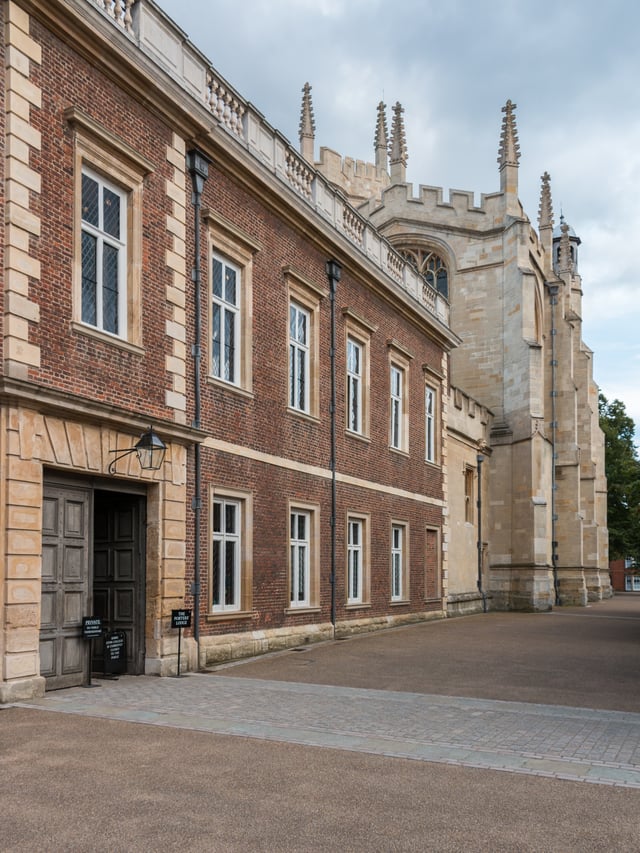
Front of Eton College
In addition to the house master, each house has a house captain and a house captain of games. Some houses have more than one. House prefects were once elected from the oldest year, but this no longer happens. The old term, "Library", survives in the name of the room set aside for the oldest year's use, where boys have their own kitchen. Similarly, boys in their penultimate year have a room known as "Debate".
There are entire house gatherings every evening, usually around 8:05–8:30 p.m. These are known as "Prayers", due to their original nature. The house master and boys have an opportunity to make announcements, and sometimes the boys provide light entertainment.
For much of Eton's history, junior boys had to act as "fags", or servants, to older boys. Their duties included cleaning, cooking, and running errands. A Library member was entitled to yell at any time and without notice, "Boy, Up!" or "Boy, Queue!", and all first-year boys had to come running. The last boy to arrive was given the task. These practices, known as fagging, were partially phased out of most houses in the 1970s. Captains of house and games still sometimes give tasks to first-year boys, such as collecting the mail from the school office.
There are many inter-house competitions, mostly in sports.
Head Masters: 1442–present
Uniform
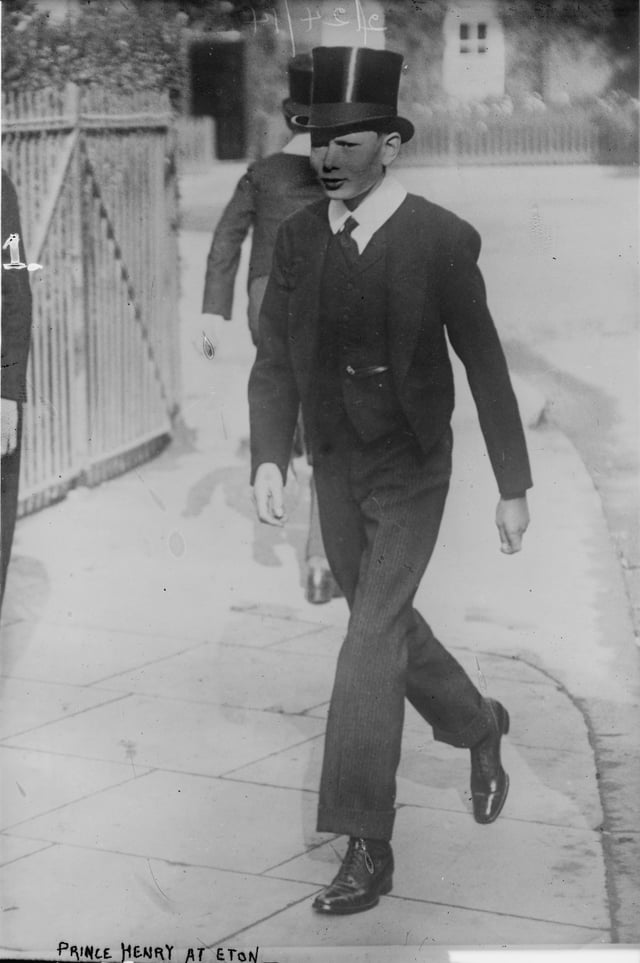
Prince Henry, Duke of Gloucester in 1914 dress of a junior Eton pupil, wearing a top hat, neck-tie and "bum-freezer", none of which are now worn
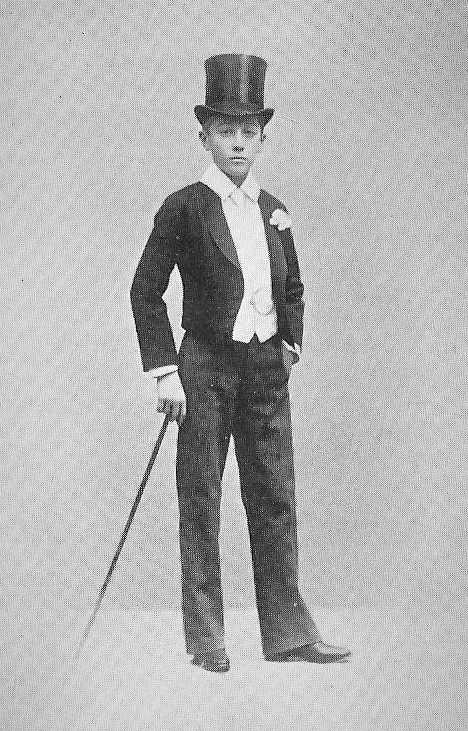
The Duke of Alba in late 1800s Eton dress
The School is known for its traditions, including a uniform of black tailcoat (or morning coat) and black waistcoat, a starched stiff collar and black pinstriped trousers. Most pupils wear a white "tie" which is a narrow strip of cloth folded over the joint of the collar to hide the collar stud, but some senior boys are entitled to wear a white bow tie and winged collar ("Stick-Ups"). There are some variations in the school dress worn by boys in authority, see School Prefects and King's Scholars sections.
The long-standing belief that the present uniform was first worn as mourning for the death of King George III in 1820[54] is unfounded. In 1862 headmaster Edward Balston, in an interview with the Clarendon Commission, noted little in the way of uniform.
Lord Clarendon: One more question, which bears in some degree upon other schools, namely with regard to the dress. The boys do not wear any particular dress at Eton? Edward Balston: No, with the exception that they are obliged to wear a white neckcloth. Lord Clarendon: Is the colour of their clothes much restricted? Edward Balston: We would not let them wear for instance a yellow coat or any other colour very much out of the way. Lord Clarendon: If they do not adopt anything very extravagant either with respect to colour or cut you allow them to follow their own taste with respect to the choice of their clothes? Edward Balston: Yes. Lord Lyttelton: They must wear the common round hat?
Edward Balston: Yes.[55]
Tutors and teaching
Teachers are known unofficially as "beaks". The pupil to teacher ratio is 8:1,[58] which is extremely low by typical UK school standards. Class sizes start at around twenty to twenty-five in the first year and are often below ten by the final year.
The original curriculum concentrated on prayers, Latin and devotion, and "as late as 1530 no Greek was taught".[59]
Later the emphasis was on classical studies, dominated by Latin and Ancient History, and, for boys with sufficient ability, Classical Greek. From the latter part of the 19th century this curriculum has changed and broadened:[60] for example, there are now more than 100 students of Chinese, which is a non-curriculum course.[61] In the 1970s, there was just one school computer, in a small room attached to the science buildings. It used punched tape to store programs. Today, all boys must have laptop computers, and the school fibre-optic network connects all classrooms and all boys' bedrooms to the internet.[62]
The primary responsibility for a boy's studies lies with his House Master, but he is assisted by an additional director of studies, known as a tutor.[63] Classes, formally known as "divisions" ("divs"), are organised on a School basis; the classrooms are separate from the houses. New blocks of classrooms have appeared every decade or so since New Schools, designed by Henry Woodyer and built 1861–63.[64] Despite the introduction of modern technology, the external appearance and locations of many of the classrooms have remained unchanged for a long time. The oldest classroom still in use, "Lower School", dates from the 15th century.
Every evening, about an hour and a quarter, known as Quiet Hour, is set aside, during which boys are expected to study or prepare work for their teachers if not otherwise engaged.[65] Some Houses, at the discretion of the House Master, may observe a second Quiet Hour after prayers in the evening. This is less formal, with boys being allowed to visit each other's rooms to socialise if neither boy has work outstanding.
The Independent Schools Inspectorate's latest report says, "The achievement of pupils is exceptional. Progress and abilities of all pupils are at a high level. Pupils are highly successful in public examinations, and the record of entrance to universities with demanding entry requirements in the United Kingdom and overseas is strong."[66]
Societies
At Eton, there are dozens of organisations known as 'societies', in many of which pupils come together to discuss a particular topic or to listen to a lecture, presided over by a senior pupil, and often including a guest speaker.[67] At any one time there are about fifty societies and clubs in existence, catering for a wide range of interests and largely run by boys.
Societies tend to come and go, depending on the special enthusiasms of the masters and boys in the school at the time, but some have been in existence for many years. Those in existence at present include: Aeronautical, African, Alexander Cozens (Art), Amnesty, Archeological, Architectural, Astronomy, Balfour, Banks (conservation), Caledonian, Cheese, Classical, Comedy, Cosmopolitan, Debating, Design, Entrepreneurship, Francophone, Geographical, Geopolitical, Global, Henry Fielding, Hispanic, History, Keynes (economics), Law, Literary, Mathematical, Medical, Middle Eastern, Model United Nations, Modern Languages, Oriental, Orwell (left-wing), Simeon (Christian), Parry (music), Photographic, Political, Praed (poetry), Rock (music), Rous (equestrian), Salisbury (diplomatic), Savile (Rare Books and Manuscripts), Shelley, Scientific, Sports, Tech Club, Theatre, Wellington (military), Wine and Wotton's (philosophy).
Among past guest speakers are Rowan Atkinson, Jeremy Burge,[68] Ralph Fiennes, King Constantine II of Greece, Kit Hesketh-Harvey,[69] John Major,[70] Boris Johnson, Ian McKellen,[71] J. K. Rowling, Katie Price, Kevin Warwick,[72] Andrew Lloyd Webber,[73] Vivienne Westwood,[74] Terry Wogan[75] and Alan Yau.[76]
Grants and prizes
Prizes are awarded on the results of trials (internal exams), GCSE and AS-levels. In addition, many subjects and activities have specially endowed prizes, several of which are awarded by visiting experts. The most prestigious is the Newcastle Scholarship, awarded on the strength of an examination, consisting of two papers in philosophical theology, moral theory and applied ethics. Also of note is the Gladstone Memorial Prize and the Coutts Prize, awarded on the results of trials and AS-level examinations in C block (Year 12); and the Huxley Prize, awarded for a project on a scientific subject. Other specialist prizes include the Newcastle Classical Prize; the Rosebery Exhibition for History; the Queen's Prizes for French and German; the Duke of Newcastle's Russian Prize; the Beddington Spanish Prize; the Strafford and Bowman Shakespeare Prizes; the Tomline and Russell Prizes in Mathematics; the Sotheby Prize for History of Art; the Waddington Prize for Theology and Philosophy; the Birley Prize for History; the Rorie Mackenzie Prize for Modern Languages; The Lower Boy Rosebery Prize and the Wilder Prize for Theology. Prizes are awarded too for excellence in such activities as painting, sculpture, ceramics, playing musical instruments, musical composition, declamation, silverwork, and design.
Various benefactions make it possible to give grants each year to boys who wish, for educational or cultural reasons, to work or travel abroad. These include the Busk Fund, which supports individual ventures that show particular initiative; the C. M. Wells Memorial Trust Fund, for the promotion of visits to classical lands; the Sadler Fund, which supports, among others, those intending to enter the Foreign Service; and the Marsden Fund, for travel in countries where the principal language is not English.
Incentives and sanctions
Eton has a well-established system for encouraging boys to produce high-standard work. An excellent piece of work may be rewarded with a "Show Up", to be shown to the boy's tutors as evidence of progress.[77] If, in any particular term, a pupil makes a particularly good effort in any subject, he may be "Commended for Good Effort" to the Head Master (or Lower Master).
If any boy produces an outstanding piece of work, it may be "Sent Up For Good",[77] storing the effort in the College Archives for posterity. This award has been around since the 18th century. As Sending Up For Good is fairly infrequent, the process is rather mysterious to many of Eton's boys. First, the master wishing to Send Up For Good must gain the permission of the relevant Head of Department. Upon receiving his or her approval, the piece of work will be marked with Sent Up For Good and the student will receive a card to be signed by House Master, tutor and division master.
The opposite of a Show Up is a "Rip".[78] This is for sub-standard work, which is sometimes torn at the top of the page/sheet and must be submitted to the boy's housemaster for signature. Boys who accumulate rips are liable to be given a "White Ticket", a form of a progress report which must be signed at intervals by all his teachers and may be accompanied by other punishments, usually involving doing domestic chores or writing lines. In recent times, a milder form of the rip, 'sign for information', colloquially known as an "info", has been introduced, which must also be signed by the boy's housemaster and tutor.
Internal examinations are held at the end of the Michaelmas half (i.e. autumn term) for all pupils, and in the Summer half for those in the first, second and fourth years (i.e. those not taking a full set of public examinations). These internal examinations are called "Trials".[79]
A boy who is late for any division or other appointments may be required to sign "Tardy Book", a register kept in the School Office, between 7:35 am and 7:45 am, every morning for the duration of his sentence (typically three days).[80] Tardy Book may also be issued for late work. For more serious misdeeds, a boy is placed "on the Bill", which involves him being summoned by the sudden entry of a prefect into one of his divisions, who announces in a loud and formal tone that at a given time a certain pupil must attend the office of the Head Master, or Lower Master if the boy is in the lower two years, to talk personally about his misdeeds.[81] The most serious misdeeds may result in expulsion, or rustication (suspension) or in former times, beating. Conversely, should a master be more than 15 minutes late for a class, traditionally the pupils may claim it as a "run" and absent themselves for the rest of its duration, provided they report their intention so to do at the school office.
A traditional punishment took the form of being made to copy, by hand, Latin hexameters. Offenders were frequently set 100 hexameters by Library members, or, for more serious offences, Georgics (more than 500 hexameters) by their House Masters or the Head Master.[82] The giving of a Georgic is now extremely rare, but still occasionally occurs.
Corporal punishment
Eton used to be renowned for its use of corporal punishment, generally known as "beating". In the 16th century, Friday was set aside as "flogging day".[83] A special wooden birching block was used for the purpose, with the boy being directed to fetch it and then kneel over it.
Beating was phased out in the 1980s. The film director Sebastian Doggart claims to have been the last boy caned at Eton, in 1984.[84]
John Keate, Head Master from 1809 to 1834, took over at a time when discipline was poor. Until 1964, offending boys could be summoned to the Head Master or the Lower Master, as appropriate, to receive a birching on the bare posterior, in a semi-public ceremony held in the Library, where there was a special wooden birching block over which the offender was held. Anthony Chenevix-Trench, Head Master from 1964 to 1970, abolished the birch and replaced it with caning, also applied to the bare buttocks, which he administered privately in his office.[85] Chenevix-Trench also abolished corporal punishment administered by senior boys. Previously, House Captains were permitted to cane offenders over the seat of the trousers. This was a routine occurrence, carried out privately with the boy bending over with his head under the edge of a table. Less common but more severe were the canings administered by Pop (see Eton Society below) in the form of a "Pop-Tanning", in which a large number of hard strokes were inflicted by the President of Pop in the presence of all Pop members (or, in earlier times, each member of Pop took it in turns to inflict a stroke). The culprit was summoned to appear in a pair of old trousers, as the caning would cut the cloth to shreds. This was the most severe form of physical punishment at Eton.[86]
Chenevix-Trench's successor from 1970, Michael McCrum, retained private corporal punishment by masters but ended the practice of requiring boys to take their trousers and underwear down when bending over to be caned by the Head Master. By the mid-1970s, the only people allowed to administer caning were the Head Master and the Lower Master.[87]
Prefects
In addition to the masters, the following three categories of senior boys are entitled to exercise School discipline. Boys who belong to any of these categories, in addition to a limited number of other boy office holders, are entitled to wear winged collars with bow ties.
Pop: officially known as ‘Eton Society’,[88] a highly glamourous high-status elite society comprising the most popular, well-regarded, confident and able senior boys. It is thus truly an elite within an elite. It is a driving ambition of many capable Eton schoolboys to be elected to Pop, and many high-performers who are refused entry to this elite consider their careers at Eton a failure. Boris Johnson was a member of Pop, whilst David Cameron (unlike his elder brother Alexander) failed to be elected, a fact which possibly fed their later political rivalry.[89] Over the years its power and privileges have grown. Pop is the oldest self-electing society at Eton. The rules were altered in 1987 and again in 2005 so that the new intake are not elected solely by the existing year and a committee of masters. Members of Pop wear white and black houndstooth-checked trousers, a starched stick-up collar and white bow-tie, and are entitled to wear flamboyant waistcoats, often of their own design. Historically, only members of Pop were entitled to furl their umbrellas[90] or sit on the wall on the Long Walk, in front of the main building. However, this tradition has died out. They perform roles at many of the routine events of the school year, including School Plays, parents' evenings and other official events, and generally maintain order. Notable ex-members of Pop include Prince William, Duke of Cambridge; Eddie Redmayne; and Boris Johnson.
Sixth Form Select: an academically selected prefectorial group consisting, by custom, of the 10 senior King's Scholars and the 10 senior Oppidan Scholars.[91] Members of Sixth Form Select are entitled to wear silver buttons on their waistcoats. They also act as Praepostors: they enter classrooms in mid-lesson without knocking and ask in a loud and formal tone, "Is (family name) in this division?" followed by "He is to see the Head Master at (time) on the bill" (the Bill, see above).[81] Members of Sixth Form Select also perform "Speeches", a formal event held five times a year.
House Captains: The captains of each of the 25 boys' houses (see above) have disciplinary powers at school level.[92] House Captains are entitled to wear a mottled-grey waistcoat.
It is possible to belong to Pop and Sixth Form Select at the same time.
In the era of Queen Elizabeth I there were two praepostors in every form, who noted down the names of absentees. Until the late 19th century, there was a praepostor for every division of the school.[83]
Sports
Sport is a feature of Eton; there is an extensive network of playing fields. Their names include Agar's Plough, Dutchman's, Upper Club, Lower Club, Sixpenny/The Field, and Mesopotamia (situated between two streams and often shortened to "Mespots").
During the Michaelmas Half, the sport curriculum is dominated by football (called Association) and rugby union, with some rowing for a smaller number of boys.
During the Lent Half it is dominated by the field game, a code of football, but this is unique to Eton and cannot be played against other schools. During this half, Collegers also play the Eton wall game; this game received national publicity when it was taken up by Prince Harry. Aided by AstroTurf facilities on Masters' field, field hockey has become a major Lent Half sport along with Rugby 7's. Elite rowers prepare for the Schools' Head of the River Race in late March.
During the Summer Half, sporting boys divide into dry bobs, who play cricket, tennis or athletics, and wet bobs, who row on the River Thames and the rowing lake in preparation for The National Schools Regatta and the Princess Elizabeth Challenge Cup at Henley Royal Regatta.
The rowing lake at Dorney was developed and is owned by the College. It was the venue for the rowing and canoeing events at the 2012 Summer Olympics and the World Junior Rowing Championships.[93]
The annual cricket match against Harrow at Lord's Cricket Ground is the oldest fixture of the cricketing calendar, having been played there since 1805. A staple of the London society calendar since the 1800s,[94] in 1914, its importance was such that over 38,000 people attended the two days' play, and in 1910 the match made national headlines.[95][96] But interest has since declined considerably, and the match is now a one-day limited overs contest.
There is a running track at the Thames Valley Athletics Centre and an annual steeplechase.
Among the other sports played at Eton is Eton Fives.
In 1815, Eton College documented its football rules, the first football code to be written down anywhere in the world.[97]
Olympic rowing
In 2006,[98] six years before the London 2012 Summer Olympic Games and London 2012 Summer Paralympic Games, Eton completed the construction of Dorney Lake, a permanent, eight-lane, 2,200 metre course (about 1.4 miles) in a 400-acre park. Eton financed the construction from its own funds. Officially known throughout the Games as Eton Dorney, Dorney Lake provided training facilities for Olympic and Paralympic competitors, and during the Games, hosted the Olympic and Paralympic Rowing competitions as well as the Olympic Canoe Sprint event.[98] It attracted over 400,000 visitors during the Games period (around 30,000 per day), and was voted the best 2012 Olympic venue by spectators.[98] Thirty medal events were held on Dorney Lake, during which Team GB won a total of 12 medals, making the lake one of the most successful venues for Team GB. The FISA President, Denis Oswald, described it as "the best-ever Olympic rowing venue".[98] In June 2013, it hosted the World Rowing Cup. Access to the parkland around the Lake is provided to members of the public, free of charge, almost all the year round.[99]
Music and drama
Music
The current "Precentor" (Head of Music) is Tim Johnson, and the School has eight organs and an entire building for music (performance spaces include the School Hall, the Farrer Theatre and two halls dedicated to music, the Parry Hall and the Concert Hall). Many instruments are taught, including obscure ones such as the didgeridoo. The School participates in many national competitions; many pupils are part of the National Youth Orchestra, and the School gives scholarships for dedicated and talented musicians. A former Precentor of the college, Ralph Allwood set up and organised Eton Choral Courses, which run at the School every summer.
In 2009, the School's musical protégés came to wider notice when featured in a TV documentary A Boy Called Alex. The film followed an Etonian, Alex Stobbs, a musician with cystic fibrosis, as he worked toward conducting the difficult Magnificat by Johann Sebastian Bach.[100][101]
Drama
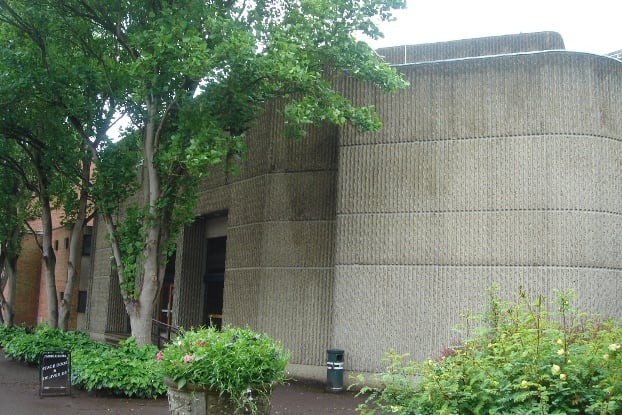
The exterior of Eton's main theatre, the Farrer.
Numerous plays are put on every year at Eton College; there is one main theatre, called the Farrer (seating 400) and 2 Studio theatres, called the Caccia Studio and Empty Space (seating 90 and 80 respectively). There are about 8 or 9 house productions each year, around 3 or 4 "independent" plays (not confined solely to one house, produced, directed and funded by Etonians) and three school plays, one specifically for boys in the first two years, and two open to all years. The School Plays have such good reputations that they are normally fully booked every night. Productions also take place in varying locations around the School, varying from the sports fields to more historic buildings such as Upper School and College Chapel.
In recent years, the School has put on a musical version of The Bacchae (October 2009) as well as productions of A Funny Thing Happened on the Way to the Forum (May 2010), The Cherry Orchard (February 2011), Joseph K (October 2011), Cyrano de Bergerac (May 2012), Macbeth (October 2012), London Assurance (May 2013), Jerusalem (October 2013), A Midsummer Night's Dream (May 2014), "Antigone" (October 2015), "The Government Inspector" (May 2016) and "Romeo and Juliet" (May 2017). On top of this, every three years, the School holds a fringe-style School Play Festival, where students and teachers write, direct and act in their own plays, hosted over the period of a week. The most recent one was held in October 2016, which hosted a wide variety of plays, from a double bill of two half an hour plays, to a serialised radio drama, written by a boy in F block (the youngest year.)
Often girls from surrounding schools, such as St George's, Ascot, St Mary's School Ascot, Windsor Girls' School and Heathfield St Mary's School, are cast in female roles. Boys from the School are also responsible for the lighting, sound and stage management of all the productions, under the guidance of several professional full-time theatre staff.[102]
Every year, Eton employs a 'Director-in-Residence', an external professional director on a one-year contract who normally directs one house play and the Lower Boy play (a school play open solely to the first two-year groups), as well as teaching Drama and Theatre Studies to most year groups.
The drama department is headed by Scott Handy (taking over from Hailz Osbourne in 2015) and several other teachers; Simon Dormandy was on the staff until late 2012. The School offers GCSE drama as well as A-level "English with Theatre Studies."
Celebrations
Eton's best-known holiday takes place on the so-called "Fourth of June", a celebration of the birthday of King George III, Eton's greatest patron.[103] This day is celebrated with the Procession of Boats, in which the top rowing crews from the top four years row past in vintage wooden rowing boats. Similar to the Queen's Official Birthday, the "Fourth of June" is no longer celebrated on 4 June, but on the Wednesday before the first weekend of June. Eton also observes St. Andrew's Day, on which the Eton wall game is played.
School magazines
The Chronicle is the official school magazine, having been founded in 1863.[104] It is edited by boys at the school. Although liable to censorship, it has a tradition of satirising and attacking school policies, as well as documenting recent events. The Connolly Review, founded in 2018, recently replaced The Junior Chronicle as the magazine for "lower boys". The Oppidan, founded in 1828,[104] was published once a half; it covered all sport in Eton and some professional events as well, but no longer exists.
Other school magazines, including The Spectrum (the Academic Yearbook), The Arts Review, and The Eton Zeitgeist have been published, as well as publications produced by individual departments such as The Cave (philosophy), Etonomics (economics), Scientific Etonian (science), Timeline (history), Praed (poetry and song), The Mayflower (English), and The Lexicon (modern languages).
Charitable status and fees
Until 18 December 2010, Eton College was an exempt charity under English law (Charities Act 1993, Schedule 2). Under the provisions of the Charities Act 2006, it is now an excepted charity, and fully registered with the Charities Commission,[105] and is now one of the 100 largest charities in the UK.[106] As a charity, it benefits from substantial tax breaks. It was calculated by the late David Jewell, former Master of Haileybury, that in 1992 such tax breaks saved the School about £1,945 per pupil per year, although he had no direct connection with the School. This subsidy has declined since the 2001 abolition by the Labour Government of state-funded scholarships (formerly known as "assisted places") to independent schools. However, no child attended Eton on this scheme, meaning that the actual level of state assistance to the School has always been lower. Eton's retiring Head Master, Tony Little, has claimed that the benefits that Eton provides to the local community free of charge (use of its facilities, etc.) have a higher value than the tax breaks it receives as a result of its charitable status. The fee for the academic year 2010–2011 was £29,862 (approximately US$48,600 or €35,100 as of March 2011),[107] although the sum is considerably lower for those pupils on bursaries and scholarships.
Support for state education
London Academy of Excellence
Eton co-sponsors a state sixth-form college, the London Academy of Excellence, opened in 2012 in the London Borough of Newham in East London,[108] the second most deprived borough in England,[109] and just over a mile from the Queen Elizabeth Olympic Park, the main venue for London's 2012 Summer Olympics. In 2015—2016, it had around 440 pupils and 32 teachers.[110] The college is free of charge and aims to get all its students into higher education.[111] The college's close relationship with Eton has led it to be described as 'the Eton of the East End'.[112] In 2015, the college reported that it had been named best sixth form in the country by The Sunday Times.[109]
Holyport College
In September 2014, Eton opened, and became the sole educational sponsor for, Holyport College, a new purpose-built co-educational state boarding and day school that provides free education for around 500 pupils. It is located in Holyport, near Maidenhead in Berkshire.[113] Construction costs were around £15 million, in which a fifth of places for day pupils have been set aside for children from poor homes, 21 boarding places for to youngsters on the verge of being taken into care, and a further 28 boarders funded or part-funded through bursaries.[114]
State school pupils
The above-described developments are running alongside long-established courses that Eton has provided for pupils from state schools, most of them in the summer holidays (July and August).
Universities Summer School
Launched in 1982, the Universities Summer School is an intensive residential course open to boys and girls throughout the UK who attend state schools, are at the end of their first year in the Sixth Form, and are about to begin their final year of schooling.[115]
Brent—Eton Summer School
Launched in 1994, the Brent—Eton Summer School offers 40–50 young people from the London Borough of Brent, an area of inner-city deprivation, an intensive one-week residential course, free of charge, designed to help bridge the gap between GCSE and A-level.[116]
Eton, Slough, Windsor and Heston Independent and State School Partnership
In 2008, Eton helped found the Eton, Slough, Windsor and Heston Independent and State School Partnership (ISSP), with six local state schools. The ISSP's aims are 'to raise pupil achievement, improve pupil self-esteem, raise pupil aspirations and improve professional practice across the schools'.[117] Eton also runs a number of choral and English language courses during the summer months.
Historical relations with other schools
Eton College has links with some private schools in India today, maintained from the days of the British Raj, such as The Doon School[118] and Mayo College.[118] Eton College is also a member of the G20 Schools Group, a collection of college preparatory boarding schools from around the world, including Turkey's Robert College, the United States' Phillips Academy and Phillips Exeter Academy, Australia's Melbourne Grammar School and Launceston Church Grammar School, Singapore's Raffles Institution, and Switzerland's International School of Geneva.
Eton has fostered a relationship with the Roxbury Latin School, a traditional all-boys private school in Boston, US. Former Eton headmaster and provost Sir Eric Anderson shares a close friendship with Roxbury Latin Headmaster emeritus F. Washington Jarvis; Anderson has visited Roxbury Latin on numerous occasions,[119] while Jarvis briefly taught theology at Eton after retiring from his headmaster post at Roxbury Latin. The headmasters' close friendship spawned the Hennessy Scholarship,[119] an annual prize established in 2005 and awarded to a graduating RL senior for a year of study at Eton. Hennessy Scholars generally reside in Wotton house.
The Doon School, India
The Doon School, founded in 1935, was the first all-boys' public school in India modelled along the lines of Eton. The School's first headmaster was an Englishman, Arthur E. Foot, who had spent nine years as a science master at Eton College, before joining Doon.[120] This led to similar slang being introduced in Doon which is still in use today, such as trials, dame, fagging, schools (as opposed to 'periods') and tuck shop.
In Doon's early years, faculty from Eton travelled to India to fill up the academic posts. Peter Lawrence was one of the first few masters to go to Doon.[121] In February 2013, Eton's Head Master Tony Little visited the Doon School in India to hold talks with Peter McLaughlin, headmaster of Doon, on further collaboration between the two schools.[122] Both schools participate in an exchange programme which sees boys from either school visiting the other for one academic term.[123]
Although the School has often been cited as 'Eton of India' by media outlets such as BBC, Channel 4, The Guardian, Financial Times, The Economist, The Daily Telegraph and Forbes, it strongly eschews the label.[124][125][126][127][128][129]
Holyport College
In September 2014 Eton College helped establish Holyport College, a state-funded free school with boarding facilities. The school is located in Holyport, Berkshire and Eton College acts as the main educational sponsor of the school.[130]
Old Etonians

Old Etonian Tie: black with Eton blue stripes
Former pupils of Eton College are known as Old Etonians.
Eton has produced twenty British Prime Ministers, including Sir Robert Walpole, William Pitt the Elder, the first Duke of Wellington, William Ewart Gladstone, the third Marquess of Salisbury, the fifth Earl of Rosebery, Arthur James Balfour, Anthony Eden, Harold Macmillan, Alec Douglas-Home, David Cameron and current Prime Minister Boris Johnson.
A rising number of pupils come to Eton from overseas, including members of royal families from Europe, Africa and Asia, some of whom have been sending their sons to Eton for generations. One of them, King Prajadhipok or Rama VII (1893–1941) of Siam, donated a garden to Eton.[131] The former Prime Minister of Thailand, Abhisit Vejjajiva, who governed from 2008 to 2011, was also educated at Eton. King Leopold III of Belgium was sent to Eton during the First World War.
Besides Prince William and Prince Harry, members of the extended British royal family who have attended Eton include Prince Richard, Duke of Gloucester and his son Alexander Windsor, Earl of Ulster; Prince William of Gloucester (1942-1972) son of Prince Henry, Duke of Gloucester; Prince Edward, Duke of Kent, his eldest son George Windsor, Earl of St Andrews and grandson Edward Windsor, Lord Downpatrick; Prince Michael of Kent and his son Lord Frederick Windsor; James Ogilvy, son of Princess Alexandra and the Honourable Sir Angus Ogilvy.; Princess Margaret's grandsons Samuel and Arthur Chatto, and Charles Armstrong-Jones, Viscount Linley, also attended Eton College, as did George Lascelles, 7th Earl of Harewood, son of Princess Mary, Princess Royal.
Nirajan Bir Bikram Shah Dev, a prince of Nepal, was also a former student, as was current Archbishop of Canterbury Justin Welby.
Old Etonians who have been writers include Henry Fielding, Thomas Gray, Horace Walpole, Aldous Huxley, Percy Bysshe Shelley, Robert Bridges, Eric Blair (aka George Orwell), Anthony Powell, Cyril Connolly and Ian Fleming. The mediaevalist and ghost story writer M. R. James was provost of Eton from 1918 until his death in 1936.
Other notable Old Etonians include scientists such as Nobel Prize winning physicist Lord Rayleigh, Robert Boyle, John Maynard Smith, J. B. S. Haldane, Stephen Wolfram and the 2012 Nobel Prize in Physiology or Medicine winner, John Gurdon; Beau Brummell; economists John Maynard Keynes and Richard Layard; philosopher Derek Parfit; Antarctic explorer Lawrence Oates; politician Alan Clark; entrepreneur, charity organiser and husband of Adele, Simon Konecki; cricket commentator Henry Blofeld; businessman Thomas van Straubenzee; explorer Sir Ranulph Fiennes; adventurer Bear Grylls; composers Thomas Arne, George Butterworth, Roger Quilter, Frederick Septimus Kelly, Donald Tovey, Thomas Dunhill, Lord Berners, Victor Hely-Hutchinson, and Peter Warlock (Philip Heseltine); Hubert Parry, who wrote the song Jerusalem and the coronation anthem I was glad; and musicians Frank Turner and Humphrey Lyttelton.
Notable Old Etonians in the media include the former Political Editor of both ITN and The Times, Julian Haviland; the current BBC Deputy Political Editor, James Landale, and the BBC Science Editor, David Shukman; the current President of Conde Nast International and Managing Director of Conde Nast UK, Nicholas Coleridge; the former ITN newscaster and BBC Panorama presenter, Ludovic Kennedy; current BBC World News and BBC Rough Justice current affairs presenter David Jessel; former chief ITV and Channel 4 racing commentator John Oaksey; 1950s BBC newsreader and 1960s ITN newscaster Timothy Brinton; 1960s BBC newsreader Corbet Woodall; the former Editor of The Daily Telegraph, Charles Moore; the former Editor of The Spectator, Ferdinand Mount; and the current Editor of The Mail on Sunday, Geordie Greig.
Notable Old Etonian film and television actors include Eddie Redmayne, Damian Lewis, Christopher Cazenove, Dominic West, Jeremy Clyde, actor and comedian Michael Bentine, Sebastian Armesto, Julian Ovenden, Jeremy Brett, Hugh Laurie, Tom Hiddleston, Ian Ogilvy, John Standing, Harry Hadden-Paton, Moray Watson, Jeremy Child, Harry Lloyd, Patrick Macnee, Adetomiwa Edun and Nyasha Hatendi.
Actor Dominic West has been unenthusiastic about the career benefits of being an Old Etonian, saying it "is a stigma that is slightly above 'paedophile' in the media in a gallery of infamy",[132] but asked whether he would consider sending his own children there, said "Yes, I would. It's an extraordinary place. ... It has the facilities and the excellence of teaching and it will find what you’re good at and nurture it",[133] while the actor Tom Hiddleston says there are widespread misconceptions about Eton, and that "People think it's just full of braying toffs. ... It isn't true... It's actually one of the most broadminded places I've ever been. The reason it's a good school is that it encourages people to find the thing they love and to go for it. They champion the talent of the individual and that's what's special about it".[134]
Thirty-seven Old Etonians have been awarded the Victoria Cross—the largest number to alumni of any school (see List of Victoria Crosses by school).
Partially filmed at Eton
Here follows a list of films partially filmed at Eton.[135]
Henry VIII and His Six Wives (1972)
Aces High (1976)
Chariots of Fire (1981)
Young Sherlock Holmes (1985)
The Fourth Protocol (1987)
Inspector Morse: Absolute Conviction (1992 TV episode)
Lovejoy: "Friends in High Places" (1992 TV episode)
The Secret Garden (1993)
The Madness of King George (1994)
A Dance to the Music of Time (1997 TV mini-series)
Shakespeare in Love (1998)
Mansfield Park (1999)
A History of Britain (2000 TV series documentary)
My Week With Marilyn (2010)
Controversies
See also
Eton and Castle – the electoral ward comprising the College
Eton Boating Song
Eton College Collections
Eton Fives
Eton mess
Eton Montem
Eton Racing Boats
The Eton Rifles – a 1979 top ten hit for the Jam about class struggle, the lyrics of which reflect contemporary attitudes toward Eton as a wellspring of the establishment
Eton Summer Course
Eton College controversies
List of the oldest schools in the world
List of Provosts of Eton College
List of head masters of Eton College
List of Victoria Crosses by school
Newcastle Scholarship

